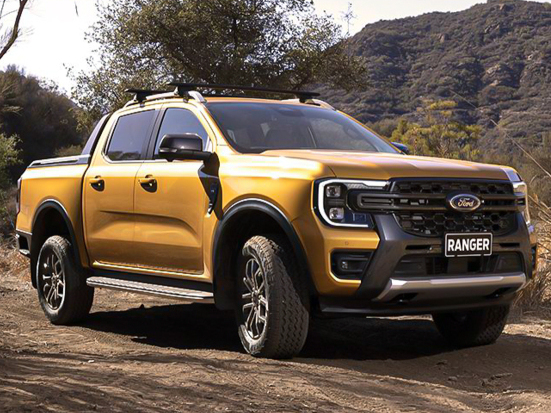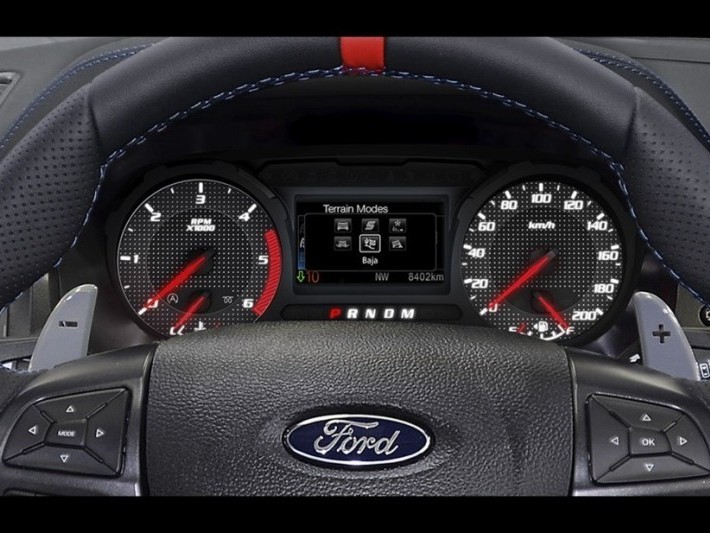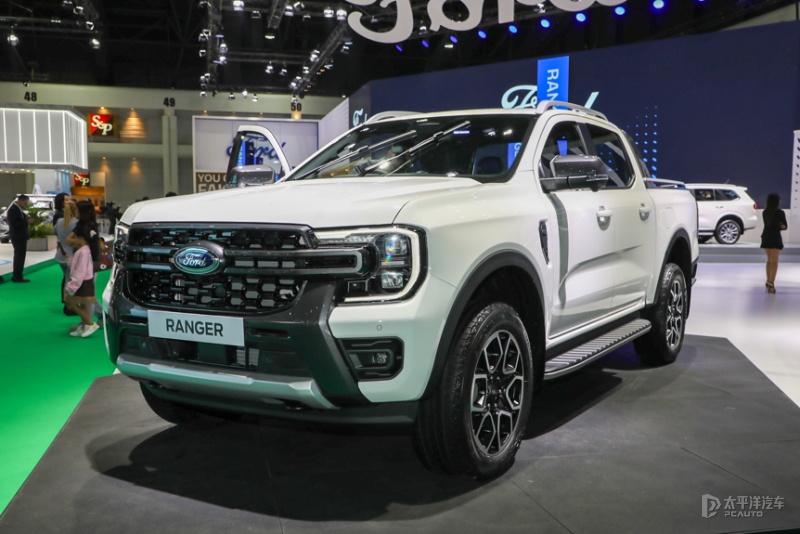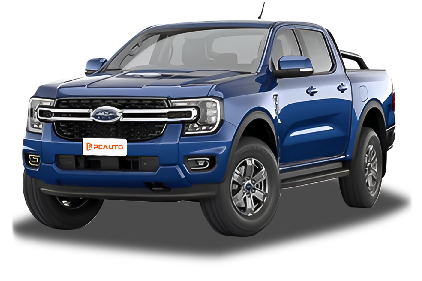Q
how heavy is a ford ranger
The weight of the Ford Ranger varies depending on the trim level and powertrain configuration. Take the popular 2023 models in the Malaysian market as an example – their kerb weight typically falls between 1,900 kg and 2,200 kg. For instance, the Wildtrak 4x4 variant equipped with the 2.0-litre bi-turbo diesel engine tips the scales at around 2,150 kg, while the base XL trim might be as light as 1,950 kg. The exact weight can also fluctuate based on optional extras like bed covers or off-road kits, as well as whether you opt for rear-wheel drive or four-wheel drive.
It's worth noting that a pickup truck's weight directly impacts its fuel efficiency and payload capacity. If you're a Malaysian user who usually hauls heavy loads or goes off-roading, paying attention to the vehicle's GVWR (Gross Vehicle Weight Rating) is crucial. The Ranger usually boasts a GVWR of over 3,000 kg, ensuring you can load it legally while still maintaining good chassis rigidity.
Additionally, while the Ranger's high-strength steel frame does add a bit of weight, it significantly improves the truck's torsional rigidity – perfect for Malaysia's diverse road conditions. In recent years, Ford has balanced weight and performance in the new Ranger models through lightweighting measures like the aluminium bonnet. This kind of technical progression is evident across the segment, so when shopping, consumers should consider a mix of power, load-carrying needs, and tax implications (such as how Malaysia's road tax is calculated).
Special Disclaimer: This content is published by users and does not represent the views or position of PCauto.
Related Q&A
Q
What is the resale value of a 2022 Ford Ranger?
The used value of a 2022 Ford Ranger depends on several factors—new car pricing, condition, mileage, trim level, and market demand all play a role in resale value. Currently, pre-owned models retain roughly 70% to 85% of their original price, depending on maintenance history and overall shape. Higher-spec Wildtrak versions typically hold their value better.
Thanks to its dependable performance, practical cargo space, and strong off-road features, this pickup maintains steady demand in the used market, especially diesel-powered variants. Well-maintained, accident-free examples with full service records fetch stronger offers, while modified trucks might turn off some buyers.
If you're thinking of selling, it’s worth getting quotes from multiple dealers or online platforms and checking listings for comparable models to gauge a realistic price range. Keep in mind that pickups generally depreciate slower than sedans, though shifting regulations and economic conditions can still impact resale value.
Q
How much is a 2022 Ford Ranger?
Here’s a natural, human-sounding translation for an automotive editor:
---
**2022 Ford Ranger Pricing Overview**
The 2022 Ford Ranger’s price varies by trim and configuration, with a starting range of roughly RM 98,000 to RM 145,000. Final pricing depends on your choice of powertrain (like the 2.0L turbo-diesel or 3.2L five-cylinder diesel) and trim level (XL, XLT, or Wildtrak). Known for its rugged chassis and off-road capability, the Ranger also packs modern tech—think SYNC® infotainment and advanced driver aids.
A quick note: Used prices fluctuate based on mileage, condition, and remaining warranty, so always check official channels or dealers for the latest quotes. As a top contender in the midsize pickup segment, the Ranger balances daily driving with workhorse utility. Cross-shop rivals like the Toyota Hilux or Isuzu D-Max if you’re weighing options.
---
This version keeps the info clear and engaging while sounding like a real editor wrote it—no robotic tone. Let me know if you'd tweak any phrasing!
Q
What Ford engines are being recalled in 2022?
Ford issued a global recall in 2022 for certain vehicles equipped with the 2.7L EcoBoost V6 engine, including popular models like the F-150 pickup and Edge SUV. The action addresses a potential design flaw in the engine's oil separator that could lead to leaks and increased fire risk.
This proactive recall reflects Ford's commitment to addressing safety concerns before they become problems. Owners can check if their vehicle is affected through Ford's official channels and visit authorized dealers for complimentary repairs.
For drivers of these models, it's smart to regularly check oil levels and inspect the engine bay—catching issues early is always better. While recalls might sound alarming, modern automakers have robust systems in place to protect customers. The key is to act promptly when notified.
To keep your engine running smoothly long-term, stick to Ford's recommended maintenance schedule and use approved oil grades. And hey, keeping detailed service records never hurts—it’s your proof of proper care down the road.
Q
Are there any problems with the 2022 Ford Ranger?
The 2022 Ford Ranger proves to be a dependable midsize pickup overall, though some owners have reported typical niggles. The infotainment system occasionally acts up with lagging or delayed responses – something that tends to improve with subsequent software updates. A handful of drivers also mention slightly jerky transmission shifts at low speeds, though this usually smooths out once you adapt to the driving mode.
Where the Ranger really shines is its rock-solid 2.0L turbo-diesel engine, which delivers consistent performance and decent fuel efficiency, making it great for long hauls or hauling loads. Just remember: staying on top of maintenance is key, especially for diesel models – don’t skip those fuel filter changes and keep an eye on the DPF system.
If you’re eyeing a used 2022 Ranger, pay extra attention to the undercarriage for signs of heavy use, since pickups often handle tough workloads. That said, this truck holds up well for durability and off-road capability. Most quirks are minor and don’t get in the way of daily driving, plus dealerships usually have fixes on hand.
Q
What is the warranty on a 2022 Ford Ranger?
The 2022 Ford Ranger comes with a standard 3-year/100,000-km warranty (whichever comes first), covering manufacturing defects and material quality issues. The powertrain is backed by a 5-year/160,000-km warranty (whichever occurs first), including core components like the engine, transmission, and drivetrain. Additionally, Ford provides a 6-year unlimited-mileage corrosion perforation warranty.
Keep in mind that warranty terms may vary depending on trim levels or promotional offers, so it’s best to check with your dealer for the latest details before purchasing. For pickup trucks, these coverage periods are fairly typical—especially the extended powertrain warranty, which often outlasts those on passenger cars, reflecting the manufacturer’s confidence in durability.
If you frequently use the Ranger for heavy-duty work or off-roading, pay extra attention to the coverage for the drivetrain and underbody components. Also, remember that sticking to scheduled maintenance at authorized service centers is crucial to keeping your warranty valid. Using aftermarket parts or skipping recommended services could void your coverage.
Q
How many miles will a 2022 Ford Ranger last?
The 2022 Ford Ranger is built to last between 200,000 to 300,000 miles (roughly 320,000 to 480,000 kilometers) with proper care and regular maintenance—though actual lifespan depends on driving habits, road conditions, and service frequency. This truck’s tough chassis and proven powertrains, especially the 2.0L EcoBlue and 3.2L Duratorq diesel engines, handle daily city and rural driving with ease. Staying on top of critical maintenance like oil changes, filter replacements, and transmission fluid services goes a long way in keeping it running.
Keep in mind: Rangers are designed for heavy-duty work, so their suspension and underbody components typically outlast regular passenger cars. If you frequently haul loads or go off-road, consider shortening service intervals and inspecting the undercarriage regularly. Don’t overlook electronics either—modern sensors and control modules play a big role in long-term reliability. Always opt for genuine parts and certified technicians to preserve the truck’s condition.
Bottom line? The Ranger sits above average in its class for durability. With proper upkeep, it’s easily a 15-year truck.
Q
Is there a recall on the 2022 Ford Ranger?
Based on current information, the 2022 Ford Ranger did undergo recalls in certain global markets for specific issues—primarily involving potential seatbelt pretensioner faults and loose rear axle bolts, which posed safety concerns. Owners can check their vehicle’s recall status by entering the VIN on Ford’s official website. We recommend staying updated through local dealer notifications or official channels to ensure your truck meets safety standards.
Keep in mind that recalls are standard manufacturer measures to address potential issues—not necessarily indicators of poor quality. They demonstrate proactive responsibility by offering free repairs.
For more details on Ranger maintenance—like diesel engine service intervals or 4WD system care—reach out to an authorized service center. They’ll provide tailored advice to keep your rig running smoothly.
Q
What are common problems with the 2022 Ranger?
**2022 Ranger Common Issues (From an Auto Editor's Perspective)**
As one of the hottest pickups in its class, the 2022 Ranger does have a few common quirks worth noting. Some owners report occasional infotainment glitches—freezing or black screens—but a software update usually sorts it out. The transmission can feel a bit jerky at low speeds, which isn’t uncommon for trucks in this segment. Just keep an eye on the fluid condition during routine maintenance.
The high-strength steel body boosts safety, but you might notice faint creaks around some panel gaps, especially on rough roads. Also, if you’re frequently towing heavy loads, keep a closer check on the turbocharged engine’s cooling system—shortening the coolant replacement interval helps.
The rear leaf springs? Great for payloads, but empty rides get bouncy. That’s just physics, not a defect. Bottom line: None of these are dealbreakers, and most fixes are a quick dealer visit away. Stick to the service schedule, keep the software updated, and you’ll dodge 90% of these minor headaches.
Q
What is the fuel economy of the Ford Ranger 2022?
The 2022 Ford Ranger's fuel efficiency varies depending on configuration and driving conditions. Models equipped with the 2.0L turbo-diesel engine average around 7.6L/100km combined, while the 3.0L V6 turbo-diesel version is slightly thirstier at approximately 8.5L/100km. Real-world figures may differ based on payload, terrain, and driving style.
Diesel engines deliver strong low-end torque, making them ideal for towing or long-distance cruising. With diesel fuel typically being cheaper at the pump, running costs can be lower over time. For city driving, keep an eye on the auto start-stop system—it helps cut down on idle fuel consumption. Regular maintenance, like air filter replacements and using the right engine oil, also plays a role in keeping efficiency optimal.
As a pickup that balances utility and performance, the Ranger's fuel economy sits mid-pack among rivals. It’s a solid choice if you need a versatile workhorse without breaking the bank at the fuel station.
Q
What engine is in a 2022 Ford Ranger?
The 2022 Ford Ranger offers a range of engine options to suit different needs. The workhorse is the 2.0L EcoBlue four-cylinder turbo-diesel, available in single-turbo (170hp/405Nm) and bi-turbo (213hp/500Nm) variants. Featuring high-pressure common rail injection, this mill delivers low-rev grunt and fuel efficiency – perfect for hauling or towing.
Some markets also get the 2.3L EcoBoost petrol engine (270hp/420Nm) with twin-scroll turbo and direct injection, catering to drivers who prioritize throttle response. All engines pair with a 10-speed auto box featuring an electronic rotary shifter and drive mode selector.
Heads-up for diesel buyers: The selective catalytic reduction (SCR) system requires periodic AdBlue top-ups to cut NOx emissions – standard stuff for modern diesels. If you regularly tackle long hauls or heavy loads, the bi-turbo diesel's 500Nm punch (available from just 1,800rpm) makes it the smart pick, especially for mountainous terrain or hot climate operation.
Popular Cars
Model Year
Car Compare
Car Photo
Latest Q&A
Q
Why is gasoline a fuel?
Gasoline can serve as a fuel because it possesses core properties suitable for providing power and the ability to convert energy. It is a hydrocarbon mixture obtained through fractional distillation and cracking of petroleum, mainly containing C5-C12 aliphatic hydrocarbons, naphthenes, and a small amount of aromatic hydrocarbons. It is characterized by volatility and flammability, with low viscosity facilitating smooth flow in injection systems, and rapid evaporation enabling quick formation of a uniform combustible mixture with air. Gasoline stores chemical energy; when ignited by a spark plug in the engine combustion chamber, it burns rapidly to release a large amount of thermal energy, which pushes the piston to move and converts into mechanical energy, providing power for vehicles such as cars and motorcycles. In addition, the anti-knock property of gasoline (measured by octane number) can adapt to engines with different compression ratios, ensuring stable operation and performance; it has a high energy density, storing more energy per unit volume, good combustion efficiency, and high availability of gas stations for convenient use. Therefore, it has become the main fuel for spark-ignition internal combustion engines and is widely used in transportation and related fields.
Q
What are 1st, 2nd, and 3rd family gases?
The first, second, and third family cars are vehicle categories classified based on the stages of family car-purchasing needs. The first family car is an entry-level economical model, such as the Perodua Axia and Proton Saga, priced at approximately 30,000 to 50,000 Malaysian ringgit. It emphasizes fuel efficiency and practicality, making it suitable for young families purchasing a car for the first time. The second family car falls into the mid-range category, offering more space and enhanced features, such as the Proton Persona and Toyota Vios, priced between 60,000 and 100,000 Malaysian ringgit, catering to the comfort requirements of growing families. The third family car is a premium model or an MPV/SUV, such as the Proton Exora and Honda CR-V, priced above 100,000 Malaysian ringgit. It boasts spacious interiors and upscale configurations, ideal for larger families or long-distance travel. Malaysian consumers typically prioritize fuel efficiency, maintenance costs, and space when selecting a vehicle. Families at different life stages adjust their car choices accordingly. For instance, small families may begin with the first category, upgrade to the second after having children, and larger families often opt for the third category.
Q
What are the four types of natural gas?
Natural gas can be classified into four main types based on its source: gas field gas (pure natural gas), associated petroleum gas, condensate field gas, and coalbed methane. Gas field gas is directly extracted from gas wells, typically containing over 90% methane with minimal impurities. Associated petroleum gas is a byproduct of oil extraction, containing not only methane but also significant amounts of other hydrocarbons such as ethane and propane. Condensate field gas yields light hydrocarbon fractions during extraction, characterized by a high methane content and small quantities of heavier hydrocarbons like pentane. Coalbed methane is extracted from underground coal seams, primarily consisting of methane and nitrogen, and must have a methane content exceeding 40% to be utilized as fuel. Due to compositional differences, these natural gas types vary in calorific value and applications. The first three are commonly used for urban gas supply, whereas coalbed methane requires purification before effective utilization. As a clean and efficient energy source, the development and utilization of these diverse natural gas types play a crucial role in optimizing energy structure.
Q
What are the three types of fuel gas?
Common fuel gases are mainly divided into three types: natural gas, liquefied petroleum gas (LPG), and manufactured gas. Natural gas is a flammable gas existing in nature, with methane as its main component. It is colorless and odorless, leaves no residue after combustion, and has high thermal efficiency, making it a clean energy source. Liquefied petroleum gas is a by-product of the petroleum refining process, whose main components include propane and butane. It is a gas at room temperature but can be converted into liquid through pressurization and cooling, facilitating storage and transportation. Manufactured gas is generated through thermochemical reactions of fossil fuels such as coal or petroleum under specific conditions, with main components including hydrogen, carbon monoxide, and methane. It has low production costs but produces certain pollution after combustion, so ventilation should be ensured during use. These three fuel gases have different application scenarios in the energy supply field, and their calorific values and usage characteristics also vary. For example, the calorific value of natural gas is approximately 33,000-36,000 kcal per cubic meter, that of LPG is about 90,000 kcal per kilogram, and that of manufactured gas is roughly 3,500-4,200 kcal per cubic meter. The different calorific values make them suitable for different energy demand scenarios such as households and industries.
Q
Is unleaded petrol a gas?
Unleaded gasoline is not a gas but a liquid fuel. It refers to gasoline with a lead content of less than 0.013 grams per liter and without the addition of tetraethyl lead as an anti-knock additive during the refining process. Its octane rating is typically 95, slightly lower than the 97 of leaded gasoline. The use of unleaded gasoline can effectively reduce emissions of harmful substances such as hydrocarbons, carbon monoxide, and nitrogen oxides in vehicle exhaust, thereby lowering pollution risks including smog, toxic gases, and acid rain. However, it should be noted that while unleaded gasoline contains no artificially added lead, it still retains trace amounts of lead from crude oil. Additionally, its combustion releases gases, particulate matter, and condensates, with particles smaller than 2 microns in diameter being particularly prone to prolonged suspension in the air and subsequent human inhalation. Thus, potential health impacts remain a concern. Currently, most vehicles can use unleaded gasoline directly, though certain models require selecting the appropriate octane grade as recommended by the manufacturer to ensure optimal engine performance and longevity.
View MoreRelated News

2025 Ford Ranger WildTrak launched, the most powerful diesel version in the Ranger lineup
MichaelAug 25, 2025

Is the Ford Ranger V6 about to enter Malaysia?
LienAug 13, 2025

Reviewing the Ford Ranger: The Dual Advantages of Rugged Appearance and Powerful Performance
Kevin WongApr 21, 2025

"Starting from RM 170,888! Detailed Explanation of Ford Ranger's Configuration and Performance, a Synonym for Practicality and Versatility?"
AshleySep 20, 2024

Ford Ranger: A Safe, Reliable, and Economical Choice of Pickup
LienMay 2, 2024
View More

















Pros
Cons